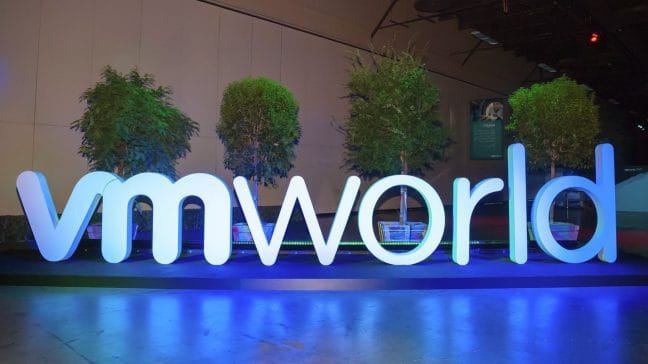During VMworld in Barcelona, VMware fired a warning shot in the field of IoT and edge computing. It has briefly shown what it is working on and what we can expect from VMworld in the coming editions. The company will focus on edge computing and Internet of Things solutions. We dare to say that this will turn many a market segment upside down and cause considerable disruption.
Their most important achievement in this area actually came at the very end of the opening keynote. A Raspberry Pi was shown on stage with the announcement that VMware Esxi is running on it. A computer with 1GB of working memory and a budget processor; for some not very exciting, for us enough information to dive deeper into it. We talked to Matthias Schorer, Lead Business Development Manager IoT EMEA at VMware.
VMware is going to virtualize on the gateway
More than ten years ago, virtualization completely changed the server market. Whereas we used to have to buy a physical server for each use case, we could suddenly cut the capacity of a server into two, three, four or even eight parts. Then multiple virtualized servers could be run on it. This resulted in cost savings on hardware and energy consumption. But more importantly, it became much easier to make backups/snapshots and to move a virtual machine if there was a hardware problem.
VMware will now try to repeat the same trick on the edge. Companies have to deal with industrial machines, office installations or perhaps just the thermostat, all of which are equipped with sensors and which have to be controlled and read via their own operating system. Of course, we hope that there will be standards for this for the most part, but the fact is that we will probably still have five standards left. In theory, we would have to build an edge computer in all those devices so that we could read the data and manage the devices.
If it’s up to VMware, that’s not necessary. They just want to build a single edge computer or gateway for the Internet, where all those devices’ operating systems can be virtualized. This means that you only need one edge computer on which everything can run. Of course, there are always exceptions, especially when a lot of computing power is really needed. But in general, you do not need much horsepower for configurations and reading out sensors.
If this really gets off the ground, VMware may take a step in every company or even in every household.

VMware will virtualize on ARM
All virtualization technology developed by VMware in the past has been based on x86 processors. That means processors from Intel or AMD. VMware has always insisted on this because 95 percent of all servers use x86 processors, perhaps more. With the advent of the Internet of Things and edge computing, this will change. We no longer need a very powerful machine by definition, but a more flexible chip that can deliver both high and low performance, but which is, above all, very energy efficient. This is the specialty of ARM processors, which on the one hand are very energy efficient and can be very powerful. On the other hand, they can tune their performance down so that the energy consumption is very low. It is not without reason that this type of chip can be found in all smartphones and tablets.
VMware has now dropped the news that they will also be virtualizing on ARM, probably starting from the next VMworld event. This will bring about major changes in many a market segment; it offers a whole host of new possibilities. ARM processors are also considerably cheaper than x86 processors. In addition, virtualization also offers the necessary security benefits. For example, you can separate environments from each other, use sandboxes or possibly even use NSX or NSX-T to apply micro-segmentation to the network.
Products that may change first
There are a number of product groups that may be subject to major changes first. Especially if virtualization on ARM becomes possible. What about routers, for example, both in companies and in people’s homes? They often use ARM chips and currently they often run a very closed Linux operating system. If this is virtualized, then it is possible, for example, to set up a next-gen firewall VM there. An advanced monitoring tool that monitors all the devices in the network could also be an option, or a malware scanner that can intervene in time in the event of a possible ransomware outbreak. This creates the possibility to simply load a VM with a specific solution onto a generic device. This is a golden opportunity for companies that sell these kinds of solutions.
Another product group that may change is security cameras. At the moment, a large part of the artificial intelligence in applications is executed in the camera itself, because it is impossible to stream all images to the cloud and analyze them directly. These systems are all closed, and companies have to build these applications according to the specifications of the camera manufacturer. In addition, it remains to be seen how well the security is subsequently arranged. If you can virtualize on the camera itself, companies can simply supply a VM with the application. In addition, the VMs can be separated from each other, which means that security is also much better arranged.
Kiosk computers will also change. Nowadays, companies and shops only have their cash register on such a unit. If you virtualize the system, you can also use it to control music systems, air conditioners, heating, lamps and security cameras.
Virtualization is also possible with containers
VMware made a big push towards containers this year by embracing the Kubernetes project and making it possible to run containers. It would, of course, be strange if VMware were to virtualize on the edge using only virtual machines and not containers. This only increases flexibility and makes it easier to perform updates. In fact, we can secretly assume that VMware will try to virtualize mainly with containers on edge devices.
IoT Pulse Center becomes a SaaS product
Soon VMware will introduce IoT Pulse Center 2.0. This new version will no longer only be available on-premise, but will also be offered as SaaS. As a result, VMware will once again be able to take some work off your hands. There is now a beta that you can participate in.
With IoT Pulse Center, it is possible to monitor and secure gateways, edge computers and sensors. It will ensure a secure connection from the cloud to the device. The status of the device can be seen from the SaaS environment. Possible problems can be detected, as can the battery status, and there are analytical tools. IoT Pulse Center has an extensive API so that data can be read.
